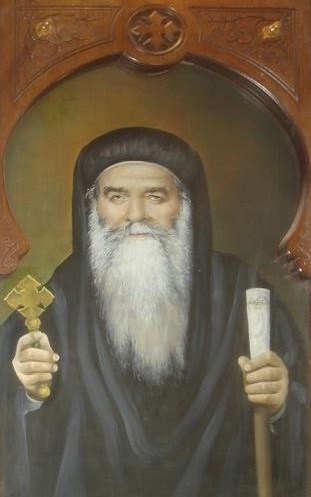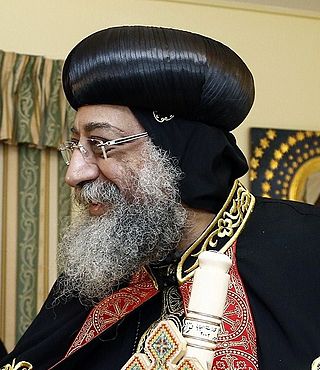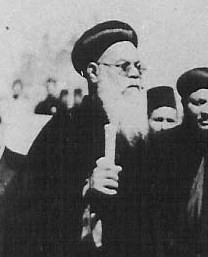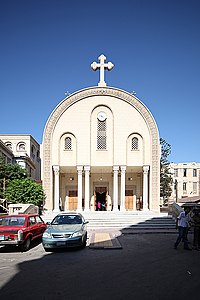
The Coptic Orthodox Church,, also known as the Coptic Orthodox Patriarchate of Alexandria, is an Oriental Orthodox Christian church based in Egypt. The head of the church and the See of Alexandria is the pope of Alexandria on the Holy Apostolic See of Saint Mark, who also carries the title of Father of fathers, Shepherd of shepherds, Ecumenical Judge and the 13th among the Apostles. The See of Alexandria is titular. The Coptic pope presides from Saint Mark's Coptic Orthodox Cathedral in the Abbassia District in Cairo. The church follows the Coptic Rite for its liturgy, prayer and devotional patrimony. Adherents of the Coptic Orthodox Church make up Egypt's largest and most significant minority population, and the largest population of Christians in the Middle East and North Africa (MENA). They make up the largest percentage of approximately 20 million Christians in Egypt

Mark the Evangelist also known as John Mark or Saint Mark, is the person who is traditionally ascribed to be the author of the Gospel of Mark. Modern Bible scholars have concluded that the Gospel of Mark was written by an anonymous author rather than an identifiable historical figure. According to Church tradition, Mark founded the episcopal see of Alexandria, which was one of the five most important sees of early Christianity. His feast day is celebrated on April 25, and his symbol is the winged lion.

The Patriarch of Alexandria is the archbishop of Alexandria, Egypt. Historically, this office has included the designation "pope".

Pope Cyril VI of Alexandria also called Abba Kyrillos VI, Coptic: Ⲡⲁⲡⲁ Ⲁⲃⲃⲁ Ⲕⲩⲣⲓⲗⲗⲟⲥ ⲋ̅ ; was the 116th Pope of Alexandria and Patriarch of the See of St. Mark from 10 May 1959 to his death.
Pope Avilius of Alexandria, was the 3rd Patriarch of Alexandria.
Pope John III of Alexandria, 40th Pope of Alexandria & Patriarch of the See of St. Mark.

St. Mark's Coptic Orthodox Cathedral is a Coptic church located in the Abbassia District in Cairo, Egypt. The cathedral is the Seat of the Coptic Orthodox Pope. It was built during the time when Pope Cyril VI of Alexandria was Pope of the Coptic Orthodox Church, and was consecrated on 25 June 1968.

The pope, also known as the Bishop of Alexandria or the Coptic pope, is the leader of the Coptic Orthodox Church, with ancient Christian roots in Egypt. The primacy in the Coptic pope, similar to the Catholic belief in the Bishop of Rome as successor to Saint Peter, is rooted in his role as successor to Saint Mark. The current holder of this position is Pope Tawadros II, who was selected as the 118th pope on November 18, 2012.

Menas of Egypt, a martyr and wonder-worker, is one of the most well-known Coptic saints in the East and the West, due to the many miracles that are attributed to his intercession and prayers. Menas was a Coptic soldier in the Roman army martyred because he refused to recant his Christian faith. The common date of his commemoration is November 11, which occurs 13 days later on the Julian calendar.

Pope Mark VIII of Alexandria (Abba Marcos VIII), 108th Pope of Alexandria & Patriarch of the See of St. Mark.

Pope Joseph II of Alexandria (Abba Yousab II) was the 115th Pope of Alexandria & Patriarch of the See of St. Mark.

The Monastery of Saint Pishoy in Wadi El Natrun, Beheira Governorate, Egypt, is the most famous monastery of the Coptic Orthodox Church of Alexandria named after Pishoy. It is the easternmost of the four current monasteries of Wadi el Natrun.
St Mary and St Mercurius Coptic Orthodox Church is the first Coptic Orthodox Church in Wales, at St Mary Street in Risca, Newport, Wales.

The Seat of the Coptic Orthodox Pope of Alexandria is historically based in Alexandria, Egypt. It is commonly known as the See of Alexandria, or the Holy See of Saint Mark, to whom the Coptic Pope claims to be the legitimate successor.
Saint Mary Coptic Orthodox Church in Haret el-Roum or the Church of the Virgin of Relief is a Coptic Orthodox church in al-Ghūrīya, Cairo near the Convent of Saint Theodore.

Coptic history is the part of the history of Egypt that begins with the introduction of Christianity in Egypt in the 1st century AD during the Roman period, and covers the history of the Copts to the present day. Many of the historic items related to Coptic Christianity are on display in many museums around the world and a large number is in the Coptic Museum in Coptic Cairo.

The Lion of Saint Mark, representing Mark the Evangelist, pictured in the form of a winged lion, is an aspect of the Tetramorph. On the pinnacle of St Mark's Cathedral he is depicted as holding a Bible, and surmounting a golden lion which is the symbol of the city of Venice and formerly of the Venetian Republic.

Saint Mark's relics, the remains of Mark the Evangelist, are held in St Mark's Basilica in Venice, Italy.















